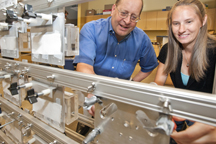Students to design, build experiment to fly on space station
July 9, 2012
 |
|
Purdue graduate student Samantha Alberts and professor Steven Collicott
discuss details of a zero-gravity flight experiment that flew this June
on NASA's "vomit comet," an airplane that induces short periods of
weightlessness by flying in steep parabolic maneuvers. NASA has selected
a team of students from Purdue and North Carolina Agricultural and
Technical State universities to design and build an experiment to be
operated on the International Space Station. The space station
experiment, which will be designed to study the physics of how fluids
change shape inside tubes in weightlessness, will be far smaller than
the vomit comet hardware. (Purdue University photo/Andrew Hancock) |
WEST LAFAYETTE, Ind. – NASA has selected a team of students from
Purdue and North Carolina Agricultural and Technical State universities
to design and build an experiment to be operated on the International
Space Station.
The universities were chosen by NASA to create an
original experiment in "capillary fluid dynamics" through the space
agency's National Lab Education Projects for the International Space
Station.
"This project will give students unique and in-depth,
real-world, team-based, original, design-build-test educational
experiences that will accelerate their learning and their careers," said
Steven Collicott,
the Purdue professor of aeronautics and astronautics whose students
will complete the project while taking his course on zero-gravity flight
experiments.
He is leading the project with John Kizito, a professor of mechanical engineering at N.C. A&T.
"The
collaboration will expose our students - the next generation of
explorers - to microgravity science and technology," Kizito said.
The
experiment is part of overall work to provide data that could help in
the design of systems that require the precise control of fluids and
gases, such as life-support equipment and fuel tanks for spacecraft.
Students will study the physics of how fluids change shape inside tubes
in weightlessness. Findings also could apply to technologies for use on
Earth such as fuel cells, medical instruments and miniature diagnostic
devices.
Primarily undergraduate engineering students at both
universities will design and build the shoebox-size experiment, develop
the procedures for operation in space, train the astronauts, process the
data, and write research papers describing the results.
"We
anticipate the experiment becoming operational in orbit in 2014 or
2015," said Collicott, who has designed previous experiments operated on
the space station and also using suborbital rockets and drop towers.
"Collaborating with Dr. Kizito to lead our students in the development
of an orbital experiment is an exciting step for me. His NASA
experiences and his teaching and research make this a good pairing."
The
project includes efforts to inspire middle school students to pursue
and enjoy topics in science, technology, engineering and math, or STEM,
fields.
"We envision curriculum development that teaches basic
STEM concepts based on the topic of the experiment," Collicott said. "A
great thing about the experiment topic is that we can design desktop
demonstrations that middle school teachers and students everywhere can
replicate and learn from in a hands-on manner."
The effort also
will include contributions from Portland State University. Other team
members are professors Mark Weislogel of Portland State and Todd Kelley
from Purdue, and consultant Emily CoBabe-Ammann.
About 20 Purdue
undergraduate students will be involved in the project each semester
over approximately three years; 10 N.C. A&T. students per semester
will be directly involved and about 20 fluid mechanics students per
semester will do coursework related to project.
Purdue graduate
student Samantha Alberts may take a leading role in the project. She
participated in a NASA-funded project that had similar goals while she
was an undergraduate at Carthage College in Kenosha, Wis.
"That
project provided invaluable research experience and directly influenced
my decision to pursue graduate school at Purdue," she said.
A
team of students taking the same zero-gravity flight experiments course
at Purdue last semester flew an experiment in June on NASA's "vomit
comet," an airplane that induces short periods of weightlessness by
flying in steep parabolic maneuvers. The experiment was designed to
study the physics of how fluids change shape inside tubes in
weightlessness.
Since 1996, students taking Collicott's class
have operated about 30 zero-gravity experiments on aircraft, and five
experiments for suborbital rocket flights have been completed or are
under way. Student experiments focus on spaceflight technology
advancement, scientific research and exploratory topics.
Writer: Emil Venere, 765-494-4709, venere@purdue.edu
Source: Steven Collicott, 765-494-2339, collicott@purdue.edu
Samantha Alberts, alberts1@purdue.edu
John Kizito, 336-285-3747, jpkizito@ncat.edu
David R. Arneke, NCAT Director of Research Communications, 336-285-3182, drarneke@ncat.edu

